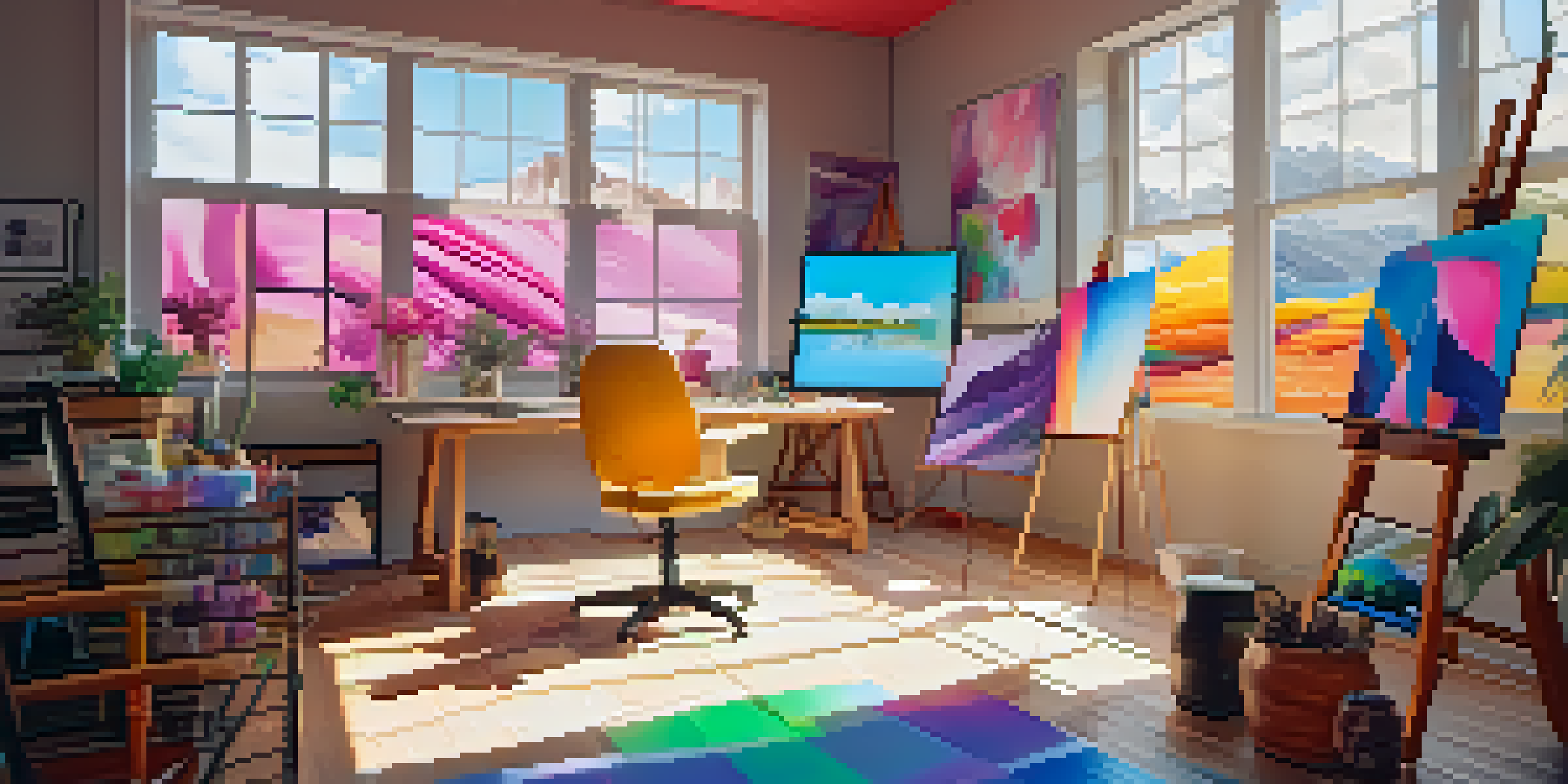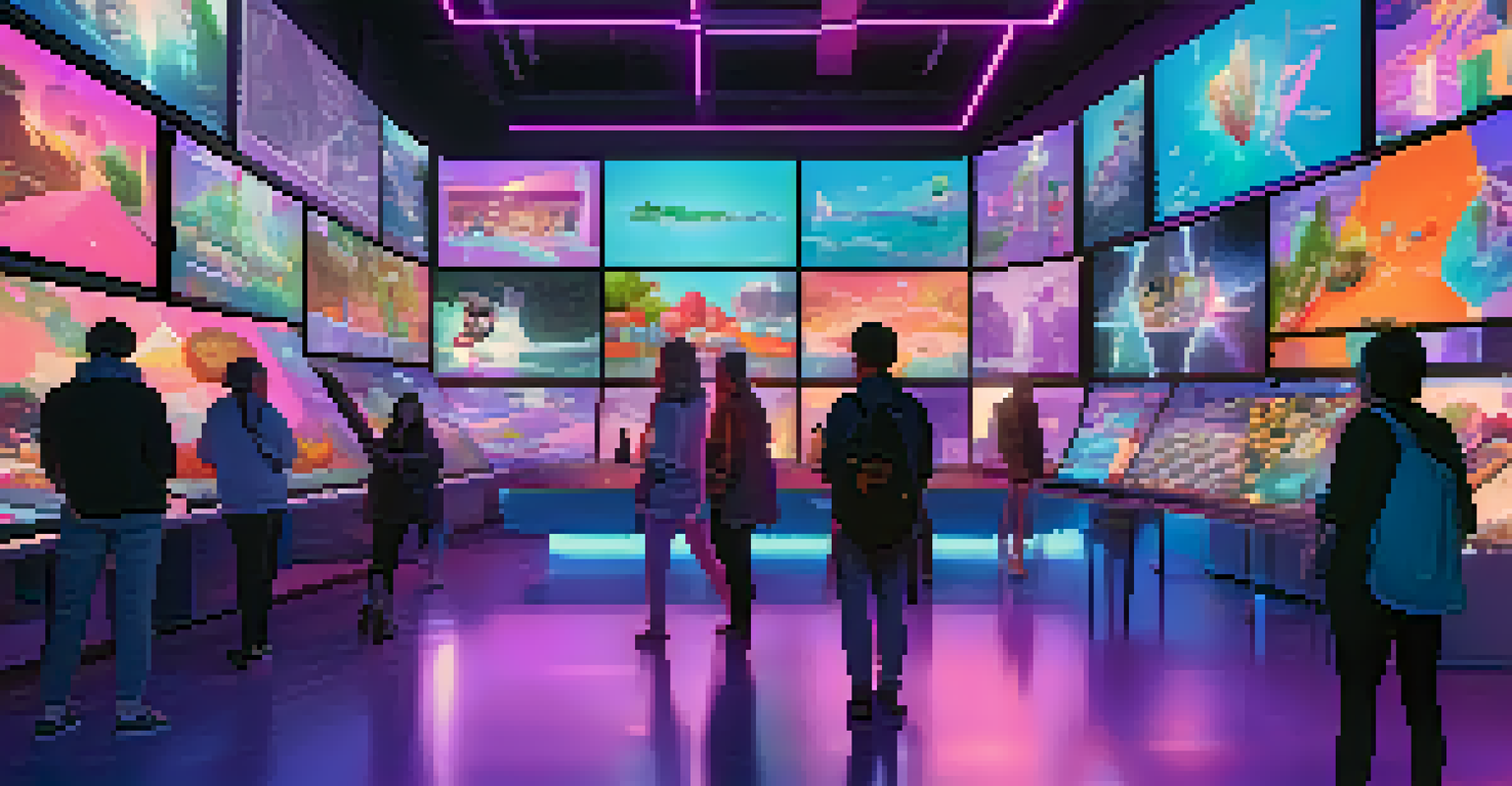How NFTs Bridge Gaps Between Visual Artists and Musicians

Understanding NFTs: A New Digital Frontier for Artists
Non-fungible tokens, or NFTs, represent ownership of unique digital assets. Unlike cryptocurrencies like Bitcoin, each NFT is one-of-a-kind, allowing artists to create and sell their work in a digital format. This uniqueness is essential for both visual artists and musicians, as it provides a new way to monetize their creative outputs.
Art is not freedom from discipline, but disciplined freedom.
For visual artists, NFTs can encapsulate illustrations, paintings, and even animations, offering an innovative avenue for exhibition and sale. Musicians benefit similarly, with the ability to sell exclusive tracks, albums, or concert experiences as NFTs. This not only diversifies their income streams but also enhances fan engagement through unique ownership experiences.
Moreover, NFTs often come with built-in royalties, meaning artists earn a percentage every time their work is resold. This ongoing financial incentive creates a supportive ecosystem, encouraging collaboration and interaction between visual artists and musicians. By understanding NFTs, artists can explore a world of possibilities that transcend traditional boundaries.
Collaboration Opportunities: Merging Visual Art and Music
One of the most exciting aspects of NFTs is how they foster collaboration between different artistic disciplines. For example, musicians can partner with visual artists to create album art that is also an NFT, turning the cover of a record into a collectible piece of art. This not only enhances the music experience but also increases the visibility of both artists involved.

Consider projects where a musician releases an album alongside a series of visual NFTs that represent each track. Fans can collect these visuals, deepening their connection to the music while supporting both artists. Such collaborations can lead to innovative projects that offer fans a multi-sensory experience, blending sound and sight in unique ways.
NFTs Empower Artists Financially
NFTs allow artists to sell directly to consumers, retaining more earnings and benefiting from resale royalties.
Additionally, platforms for NFTs often encourage artists to collaborate by featuring joint projects, helping them reach wider audiences. These partnerships can transform how fans interact with art and music, making the experience more immersive and engaging. In a digital world, the fusion of visual art and music through NFTs can help create a richer cultural experience.
The Role of Digital Platforms in NFT Distribution
Digital platforms play a crucial role in the distribution and promotion of NFTs, making it easier for artists to share their work. Platforms like OpenSea, Rarible, and Foundation allow artists to create, showcase, and sell their NFTs directly to consumers. This accessibility democratizes the art market, enabling emerging artists to gain exposure alongside established names.
The future belongs to those who believe in the beauty of their dreams.
These platforms also offer tools for artists to collaborate more effectively. For instance, musicians can easily find visual artists to work with and vice versa, creating a marketplace for creative partnerships. This interconnectedness can lead to innovative projects that might not have been possible in traditional settings.
Furthermore, the rise of social media has amplified this trend, allowing artists to promote their NFT drops directly to their followers. By leveraging digital platforms, artists can build communities around their work, fostering a sense of belonging and mutual support. In this way, the digital landscape not only facilitates sales but also nurtures relationships between artists and fans.
Building a Community: Engaging Fans Through NFTs
NFTs offer a unique way for artists to engage with their fanbase, turning passive listeners into active participants. By owning a piece of an artist's work, fans can feel more connected and invested in the creative journey. This sense of ownership can lead to a more loyal following, which is invaluable in today’s competitive creative landscape.
For example, some musicians are now offering exclusive NFT experiences, such as virtual meet-and-greets or behind-the-scenes content, for fans who purchase their NFTs. This not only adds value to the NFT itself but also fosters a deeper relationship between the artists and their fans. Visual artists can do something similar by providing exclusive access to their creative process or future projects.
Collaboration Enhances Creativity
NFTs foster innovative partnerships between visual artists and musicians, creating unique experiences for fans.
Communities built around NFTs often thrive on interaction, with fans sharing their collections and experiences on social media. This communal aspect enhances the overall value of the NFT, as it becomes a shared experience among supporters. In this way, NFTs empower fans to play an active role in the creative ecosystem.
The Financial Impact of NFTs on Artists’ Earnings
The financial implications of NFTs can be transformative for artists. Traditional methods of selling art and music often involve intermediaries, like galleries and record labels, which can take significant cuts from sales. With NFTs, artists can sell directly to consumers, allowing them to retain a larger portion of their earnings.
Moreover, the ability to set royalties on resales means that artists can continue to benefit from their work long after the initial sale. This creates a sustainable income model that can support artists throughout their careers, as they earn from both primary sales and secondary markets. It’s a win-win situation that encourages artists to innovate and create more.
However, it’s important to remember that financial success with NFTs requires marketing savvy and an understanding of the digital landscape. Artists must promote their work effectively to reach a broad audience. Yet, as more artists explore this avenue, the potential for significant earnings continues to grow, making NFTs an exciting prospect for the creative community.
Challenges and Considerations in the NFT Space
While NFTs present many opportunities, they are not without challenges. One of the primary concerns is the environmental impact of blockchain technology, as many NFT transactions require substantial energy consumption. Artists and collectors alike are increasingly aware of these issues, prompting discussions about sustainable practices within the NFT space.
Additionally, the market for NFTs can be volatile, with prices fluctuating dramatically. This uncertainty can be daunting for artists who are used to more stable income streams. It’s essential for creatives to approach the NFT market with caution and to understand the risks involved, especially when investing time and resources into creating NFTs.
Building Stronger Fan Communities
NFTs engage fans by providing ownership experiences, transforming them from passive listeners into active participants.
Finally, there’s the issue of copyright and ownership, which can become complicated in the digital realm. Artists must ensure they understand the legal aspects of NFTs to protect their work adequately. By navigating these challenges thoughtfully, artists can more effectively harness the power of NFTs to bridge the gap between visual art and music.
The Future of Art and Music: A New Collaborative Landscape
As we look to the future, it’s clear that NFTs are reshaping the landscape of art and music. The potential for collaboration between visual artists and musicians is greater than ever, opening doors to innovative projects that engage audiences in new ways. This evolution has the power to redefine how we consume and appreciate creative works.
Furthermore, as more artists embrace NFTs, we may see the establishment of new norms and standards within the creative community. This shift could lead to more transparent practices, fair compensation, and a greater emphasis on collaboration. Artists will need to adapt and evolve, but the potential rewards are significant.

Ultimately, the fusion of visual art and music through NFTs represents a significant cultural shift. By breaking down traditional barriers, artists can create experiences that resonate more deeply with fans, fostering a vibrant community that celebrates creativity. The future of art and music is bright, and NFTs are leading the way into this exciting new era.